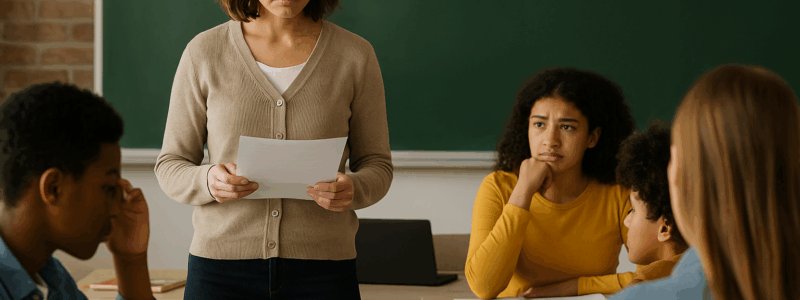The clock strikes 3:15 PM, and you’re staring at twenty confused faces after explaining fractions three ways. Every teacher knows this moment when lessons don’t land as expected.
So what separates teachers who stay frustrated from those who grow? Successful teachers don’t just move on, hoping tomorrow goes better. Instead, they pause and dig deeper. This practice is called reflective teaching.
We’ll start with simple steps to begin self-reflection, then show you which teaching areas to focus on first. Next, you’ll learn easy tools that work, and finally learn how to turn those insights into real improvements in your classroom
Teachers who master this see dramatic improvements in student engagement and confidence. Ready to transform tough teaching days into your biggest wins?
Your First Steps Into Teacher Self-Evaluation
Here’s what most teaching guides won’t tell you: self-evaluation for teachers feels scary because it means facing our mistakes head-on. And nobody enjoys realizing their “brilliant” lesson plan flopped like a pancake on Sunday morning.

But flip that script: this uncomfortable feeling actually signals that growth is about to happen. Think of self-assessment like looking in the mirror before leaving the house. Sure, you might notice your hair is messy, but now you can fix it before anyone else sees.
Ready to put this into practice? Start with something super simple that won’t overwhelm you. After school, grab your coffee and ask yourself two quick questions: What made my students light up today, and what made them check out completely? Our experience working with hundreds of teachers shows that this tiny habit creates big changes in just three weeks.
The magic happens when you treat these observations as helpful data, not personal attacks on your teaching abilities. Once you’re ready to start, knowing what to focus on makes all the difference.
What to Look At When Evaluating Your Teaching
Most teachers try to evaluate everything at once and get nowhere. These four areas give you the biggest impact for your effort. Focus here first, and you’ll see meaningful changes in your teaching effectiveness.
Real Classroom Management Solutions
Pay attention to your students’ body language during transitions and directions. Ask yourself this: do they respond quickly like a well-oiled machine, or do you sound like a broken record repeating instructions? Once you watch these patterns, you will know when your classroom is easy to manage and when it’s hard work.
Lesson Planning and Delivery Success
Lesson pacing affects student understanding more than most teachers realize. You either race through content while students look confused, or drag through material while watching kids mentally check out. The sweet spot happens when learning flows naturally without feeling rushed or painfully slow.
Student Engagement Signals
You know students are engaged when specific behaviors show up. They ask unexpected questions, lean forward instead of slouching, and focus without you constantly redirecting them. These signals reveal when your lessons hit the mark with student interests.
Parent and Student Communication
We understand how one conversation can completely change your teaching day. The most obvious thing? How clearly you explain assignments, provide feedback, and address student concerns determines whether your day flows smoothly or turns chaotic. Clear communication stops confusion and builds trust, while mixed-up messages create unnecessary stress for everyone involved.

After observing thousands of classrooms, these four areas we’re discussing right now consistently deliver the biggest improvements. Since the National Education Association has already created frameworks around these exact practices, you get practical tools that make strengthening your communication both simple and rewarding.
Simple Tools That Make Self-Assessment Easy
You don’t need fancy software or complicated systems to get started. Now, we’ll walk you through some proven teacher improvement strategies that will streamline your reflection process:
- Teaching Reflection Journal: A simple notebook becomes your teaching laboratory. In that notebook, jot down what worked, what flopped, and why certain approaches succeeded or failed. Our experts recommend just three sentences daily, like writing teaching tweets that track your progress.
- Strategic Lesson Recording: Once a week, pull out your phone during transitions, student responses, or tricky concepts. These short clips reveal blind spots you miss in real time. Watching yourself teach feels strange at first, just like hearing your recorded voice.
- Student Feedback Collection: Want to know if your lesson actually landed? Ask students two quick questions on exit tickets: what did you learn, and what confused you? Their brutally honest answers become your most reliable teaching data.
- Peer Observation Partnerships: Something magical happens when another teacher steps into your classroom space. Their outside perspective catches strengths you never recognized and habits you didn’t realize existed. You return the favor by observing their methods, naturally absorbing techniques that transform your own practice.
Creating Step-by-Step Teaching Improvements
You’ve figured out what’s wrong with your lessons, but now what? Actually fixing those issues feels completely different from just knowing about them. It’s like knowing that you need to clean your entire house but not knowing which room to tackle first.

So, instead of aiming for perfection overnight, choose just one area to work on. Pick the problem that nags at you most each day and tackle that first. Maybe your class drags their feet switching activities, or they lose focus during worksheets. But give yourself a measurable goal, like “cut transition time to two minutes by next month.”
We’ve watched this play out in classroom after classroom. Teachers who fix one thing at a time actually see changes happen, while those who try changing everything usually burn out and quit trying. Keep track of your small wins each week, do a little happy dance when things improve, and you’ll be amazed at how fixing one problem often fixes others, too.
Making Reflective Teaching Your Superpower
Make self-reflection a daily habit through reflective teaching practices. When you do this, it becomes your teaching secret weapon. You will trust yourself more and feel good about your choices. Your students will enjoy learning in your class.
Teachers everywhere want this growth. Thousands visit Bill Jason’s teaching blog every day. They share experiences in the forum and find trusted resources on Ontheculture. This community welcomes educational companies to connect with teachers through banner ads, newsletters, and workshops.
As you continue this journey, remember this truth. Great teaching means staying curious, making small changes, and keeping your love for teaching strong.

